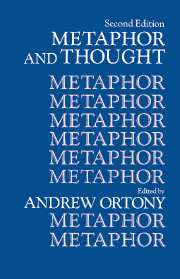Book contents
- Frontmatter
- Contents
- List of contributors
- Preface to the second edition
- Preface to the first edition
- 1 Metaphor, language, and thought
- METAPHOR AND MEANING
- 2 More about metaphor
- 3 Figurative speech and linguistics
- 4 The semantics of metaphor
- 5 Some problems with the notion of literal meanings
- 6 Metaphor
- 7 Language, concepts, and worlds: Three domains of metaphor
- 8 Observations on the pragmatics of metaphor
- METAPHOR AND REPRESENTATION
- METAPHOR AND UNDERSTANDING
- METAPHOR AND SCIENCE
- METAPHOR AND EDUCATION
- References
- Author index
- Subject index
5 - Some problems with the notion of literal meanings
Published online by Cambridge University Press: 05 June 2012
- Frontmatter
- Contents
- List of contributors
- Preface to the second edition
- Preface to the first edition
- 1 Metaphor, language, and thought
- METAPHOR AND MEANING
- 2 More about metaphor
- 3 Figurative speech and linguistics
- 4 The semantics of metaphor
- 5 Some problems with the notion of literal meanings
- 6 Metaphor
- 7 Language, concepts, and worlds: Three domains of metaphor
- 8 Observations on the pragmatics of metaphor
- METAPHOR AND REPRESENTATION
- METAPHOR AND UNDERSTANDING
- METAPHOR AND SCIENCE
- METAPHOR AND EDUCATION
- References
- Author index
- Subject index
Summary
In his paper, Professor Sadock brings to the fore a fundamental dilemma of semantic analysis as practiced by many linguists and modern philosophers. The approach adopted by these workers is committed to the existence of a sharp distinction between what an utterance might mean (that is, its literal meaning) and what that utterance is, or can be, used to convey. (See, for example, Searle's chapter [this volume] which emphasizes the distinction between “sentence meaning” and “utterance meaning.”) To a linguist interested in form-meaning pairs, or to a philosopher interested in truth conditions on expressions, this distinction might be crucial. In these cases, the concern is to build a theory of literal meaning and to assign conveyed meanings to the application of unspecified psychological processes not specific to language. As a psychologist I find myself primarily interested in the mechanisms whereby meanings are conveyed. Whatever role “literal meanings” (as defined by these linguists and philosophers) might play in the comprehension of language (that is, in the determination of what some utterance conveys), psychological theory must concern itself with conveyed meanings.
Sadock, arguing from a linguistic perspective, makes an interesting comparison between what he calls figurative and what he calls conventional language use. His analysis leads him to conclude that “conventional” and “figurative” do not form two well-defined categories of utterances as implied by most theories of language. Rather a particular utterance may be more-or-less figurative and more-or-less conventional.
Information
- Type
- Chapter
- Information
- Metaphor and Thought , pp. 71 - 82Publisher: Cambridge University PressPrint publication year: 1993
Accessibility standard: Unknown
Why this information is here
This section outlines the accessibility features of this content - including support for screen readers, full keyboard navigation and high-contrast display options. This may not be relevant for you.Accessibility Information
- 27
- Cited by
